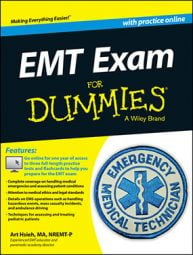The EMT exam will ask you questions about the urinary system. Located in the retroperitoneal space in the flanks, kidneys are the body’s main filters. They primarily regulate the balance of water and various electrolytes within the body, as well as remove certain toxins, which helps to control the body’s blood pressure.
Urine is formed as these substances are filtered out of the bloodstream, which passes through ureters into the urinary bladder. When the bladder becomes full, it triggers the reflex that makes you urinate. The urine is released from the bladder and travels out of the body via the urethra.
The kidneys can be affected by a variety of factors. Kidney failure can be acute, happening within a few days as a result of a sudden change, such as hypoperfusion, drug abuse, dehydration, certain medications, and kidney stones. Acute failure can sometimes be reversed.
Chronic kidney failure usually results from diseases such as hypertension or diabetes. The condition is usually not reversible. Chronic kidney failure patients require artificial filtering of their blood, called hemodialysis, that’s done by using a specialized machine. It can also be done at home with special fluids that are pumped into the abdominal cavity. This procedure is called peritoneal dialysis.
Signs of kidney failure include swelling around the hands and feet; nausea and vomiting; and in more severe cases, confusion, altered mental status, and seizures.
![[Credit: Illustration by Kathryn Born, MA]](https://www.dummies.com/wp-content/uploads/439721.image0.jpg)
Dialysis patients are at risk for developing pulmonary edema (fluid in the lungs) if they don’t perform their treatments according to schedule. If they become short of breath, confirm that their blood pressure is adequate and sit them up to help them breathe. If the blood pressure is too low, lay the patient supine and be prepared to assist ventilations with a bag-valve mask and oxygen.
Patients may not have an ability to urinate normally. In some situations, a urinary catheter, or sterile tube, is passed through the urethra into the bladder, allowing urine to drain passively. Sometimes these catheters can become infected, causing the patient to become sick and weak.
Look for signs of fever, chills, and body aches; if there is a Foley bag attached to the catheter, check to see whether the urine is a dark color, very cloudy, or even contains blood. Treatment for this condition is supportive only, keeping the patient comfortable and avoiding anything by mouth.
Sometimes the urine that the kidneys produce is so concentrated that salts clump together, or precipitate. As more crystals clump, they form kidney stones that then have to pass through the ureter on the way to the bladder. The stones can get large enough that they become difficult to pass.
In addition, they’re quite sharp and tear into the sides of the ureter, causing severe pain and bleeding. The pain tends to occur in the flank, the area between the leg and abdomen, and travels downward toward the urethra as the stone passes. In worst-case scenarios, the stone becomes too large to pass, causing urine to back up into the kidney, which can induce kidney failure.
Unfortunately there is little an EMT can do to help with the pain and discomfort of kidney stones. Keep the patient comfortable and transport gently.
An 80-year-old male is lethargic, dizzy, short of breath, and feeling weak. He is bedridden at home after a stroke. According to a caregiver, he has not been well in a week and has had a fever, chills, and body aches.
There is a Foley catheter; you note there is a small amount of dark, cloudy urine in the bag. The patient feels very warm to the touch, and has flush, dry skin. His blood pressure is 86/60 mm Hg, his heart rate is 120, and he is breathing 24 times per minute. His oxygen saturation level is 95 percent. Which of the following activities is most appropriate at this point?
(A)Place patient in a semi-Fowler’s position and administer high-flow oxygen with a nonrebreather mask.
(B)Place patient in a sitting position and administer low-flow oxygen with a nasal cannula.
(C)Place patient in a supine position and continue with a detailed physical examination.
(D)Place patient in a supine position and prepare to transfer the patient to your gurney.
The best answer is Choice (D). A lot of information is provided in the scenario, but the patient’s low blood pressure and fast heart rate indicate shock. The urinary catheter shows signs of infection, which may point to sepsis and septic shock.
The patient’s blood pressure is too low to have him in a semi-Fowler’s or sitting position, as Choices (A) and (B) suggest, and taking more time on-scene, as is the case with Choice (C), delays the time to definitive care. You can further assess the patient in the ambulance during transport.

